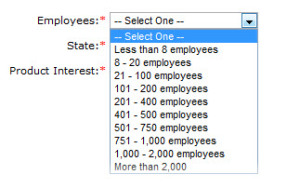Top 5 Ways to Keep Your B2B Web Lead Data Clean
January 6, 2009 3 Comments
Ardath Albee wrote that you can lift revenues 70% by cleaning up dirty prospect data. I don’t think we need much more of an incentive than that to start keeping our data clean.
CRM systems do many things extremely well. Deduplication of lead/prospect data, however, does not often seem to be one of them. The following are my four favorite things you can do to keep your CRM clean (at least in terms of the leads that come in from your site):
1. Automatic deduplication at the web form level — the same person filling out the form multiple times only creates one lead/prospect (but you still capture the activity).
2. Data validation at the form level — at the minimum, ensure that email addresses are in a valid format ([email protected], etc.). Even better is setting up your form to ping the domain in real-time and ensure that it has an actual mail exchange record. The latter method prevents people from entering things like [email protected] (which would pass the first test). At my company we take this one step further and actually do not accept free/ISP email addresses. We do not want our sales reps following up with Yahoo! or Gmail addresses.
If the visitor’s email address fails validation, be sure to provide a soft error (see below) message as soon as they tab off of the field as opposed to having them click the submit button, only to be surprised by a glaring error notification.
(soft error example)
3. Limiting choices via drop downs instead of free-form text — this makes fields like industry, job title, etc. much more usable later as you will not get permutations of the same title (e.g. VP, Vice President, etc.). This also makes things easier for the visitor as he or she can typically fill the form out faster than with free text fields.

Predefined Field Values = Better Data
4. Keep bots away with built in spam prevention. If left unchecked, bots can quickly fill a company’s database with gibberish. Many companies (including Google) do this via captchas (an additional field where you enter a string of text or a number to prove that you are indeed a human). I prefer to instead use a hidden spam trap that humans never need to see or deal with. Captchas, while effective in term of spam prevention, can frustrate visitors and drive down your conversion rate.
So how do you do all of this?
Each of the techniques above can be accomplished with either some custom programming or via a marketing automation solution. Either way, the technology is out there and it will make your life easier and your data cleaner.

